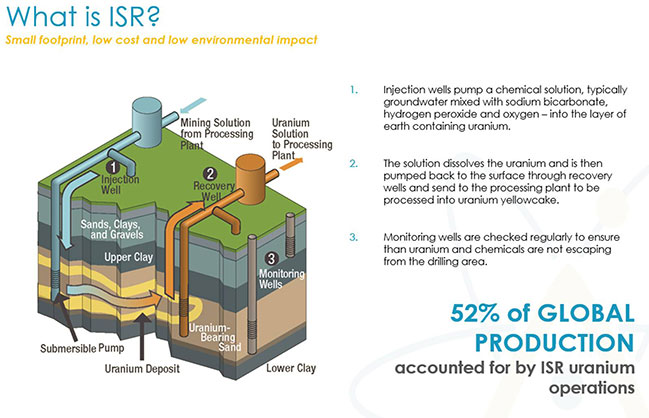Projects
ISR Explained

The ISR Process
The In-Situ Recovery (ISR) process is a form of solution methods. It differs dramatically from conventional uranium recovery techniques. The ISR technique avoids the movement and milling of significant quantities of rock and ore as well as mill tailing waste associated with more traditional methods. It is generally more cost effective and environmentally benign than conventional methods. Historically, the majority of United States uranium production resulted from either open pit surface mines or underground techniques.
The ISR process was first tested for the production of uranium in the mid-1960s and was first applied to a commercial-scale project in 1975 in South Texas. It was well established in South Texas by the late 1970’s, where it was employed in about twenty commercial projects, including two operated by us.
In the ISR process, groundwater fortified with oxygen and other solubilizing agents is pumped into a permeable ore body causing the uranium contained in the ore to dissolve. The resulting solution is pumped to the surface. The fluid-bearing uranium is then circulated to an ion exchange column on the surface where uranium is extracted from the fluid onto resin beads. The fluid is then re-injected into the ore body.
When the ion exchange column’s resin beads are loaded with uranium, they are removed and flushed with a salt-water solution, which strips the uranium from the beads. This leaves the uranium in slurry, which is then dried and packaged for shipment as uranium concentrates.
For greater operating efficiency and lower capital expenditures, when developing new well fields we use a well field specific remote ion exchange methodology as opposed to a central plant. Instead of piping the solutions over large distances through large diameter pipelines and mixing the waters of several well fields together, each well field is being mined using a dedicated satellite ion exchange facility. This allows ion exchange to take place at the well field instead of at the central plant. A well field consists of a series of injection wells, production (extraction) wells and monitoring wells drilled in specified patterns. Well field pattern is crucial to minimizing costs and maximizing efficiencies of production.
Contact
Westwater Resources, Inc. (WWR), is an explorer and developer of US-based mineral resources essential to clean energy production.
Sign up to receive emails of all the latest News Releases from Westwater Resources here.
Headquarters
6950 South Potomac Street, Suite 300
Centennial, CO 80112
Kellyton Graphite Processing Plant
349 McClellan Industrial Drive
Kellyton, AL 35089